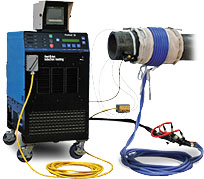Induction heating is by far the most convenient and cost-efficient material heating process for the present industrial generation. To attain a highly efficient induction heating process, all you need is an electrically conducting object when subjected to varying intensities of the magnetic field. Hysteresis and losses due to eddy current go hand-in-hand to initiate the process of induction heating within your electrically conducting field.
How does your induction heating machine work?
To initiate the induction heating process, an induction machine first pulses DC at a high-frequency range. Ideally, this frequency range undergoes optimization at 160 kHz to induce. This direct current pulsing introduces constant magnetic field change. This magnetic field change introduces eddy currents within your conductive material near its coil. Hysteresis thereby heats up all the ferromagnetic material that is present there. The heat is generated due to the rapid change introduced in the magnetic field.
This process of induction heating is highly efficient compared to other alternatives as the heat wastage here is much less. Throughout the process of induction heating, there is no contact taking place in between your inductor machine and the parts subjected to it. You will not find the presence of any combustion gases either. Place the material you want to heat in a setting, isolated from the main power supply.
Here are some part characteristics to keep an eye on
Magnetic or non-magnetic in nature
Heating of magnetic material is relatively more comfortable than a non-magnetic variant. Besides the heat generated by eddy currents, the magnetic materials itself produce some heat described as the hysteric effect. Relative resistance or permeability of magnetic material is around 100 to 500 while that of non-magnetic material is around one.
Thick or thin
As around 85 percent of the heating process takes place on the surface of the material, small or delicate parts heat up more quickly in comparison than the thicker variants.
Resistivity
Materials possessing higher electrical resistivity are able to actively resist the current flow. This process quickly produces heat.
Manufacturers
of induction heating machines are
emphasizing more on their product quality control with the introduction of
cutting edge induction technology. Red-D-Arc is a prominent name in this
regard.












0 comments:
Post a Comment